In the world of agricultural and microbiological research, a significant breakthrough has been made that could reshape how we understand and utilize bacterial interactions in the soil. Devashish Pathak, a researcher from the Division of Microbiology at the ICAR–Indian Agricultural Research Institute in New Delhi and the Department of Microbiology at Dr Rajendra Prasad Central Agricultural University in Pusa, India, has developed a novel method for quantitatively estimating hydrogen cyanide (HCN) production in bacteria. This discovery, published in the journal Bio-Protocol (which translates to “Life Protocol” in English), promises to bring a new level of precision to the study of microbial dynamics in the rhizosphere, the root zone of plants where critical ecological interactions occur.
Hydrogen cyanide, a volatile compound produced by various bacterial species, plays a crucial role in biological control and microbial competition. It inhibits the respiratory enzymes of plant pathogens, effectively acting as a natural biocontrol agent. However, until now, the methods for detecting HCN have been largely qualitative and lacking in standardization. “The volatile nature of HCN and the absence of stable reference standards have made quantitative assessment challenging,” explains Pathak. His research introduces a simplified colorimetric method that can accurately measure HCN production in both Gram-positive and Gram-negative bacteria.
The method involves observing a color change due to the formation of the isopurpurate complex, which is then eluted and quantified by measuring absorbance at 625 nm. Potassium ferrocyanide is used as a standard, offering a stable and controlled release of cyanide ions for calibration. This approach avoids the early volatilization errors associated with more dissociative salts like KCN. “Our protocol demonstrated high sensitivity, capable of detecting HCN at concentrations as low as parts per million, with a strong correlation to the standard curve,” Pathak notes.
The implications of this research are far-reaching. Accurate quantification of HCN production can enhance our understanding of microbial interactions in the rhizosphere, leading to more effective biocontrol strategies for plant pathogens. This could translate into significant commercial impacts for the agricultural sector, where sustainable and eco-friendly pest management practices are increasingly in demand.
Moreover, the method’s simplicity and cost-effectiveness make it accessible to a broader range of researchers and institutions. “While a universally adopted method is still lacking due to standardization challenges and HCN volatility, our protocol marks a significant advancement toward accurate and accessible quantitative assessment,” Pathak states. This breakthrough could pave the way for future developments in microbiological and agricultural applications, ultimately contributing to more sustainable and productive farming practices.
As the agricultural industry continues to evolve, the need for precise and reliable methods to study microbial interactions becomes ever more critical. Pathak’s research represents a step forward in this direction, offering a tool that could help unlock new insights into the complex world of soil microbiology. With the publication of this study in Bio-Protocol, the scientific community now has a valuable resource to build upon, potentially leading to innovative solutions for some of the most pressing challenges in agriculture today.

